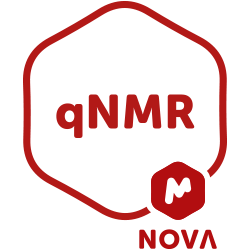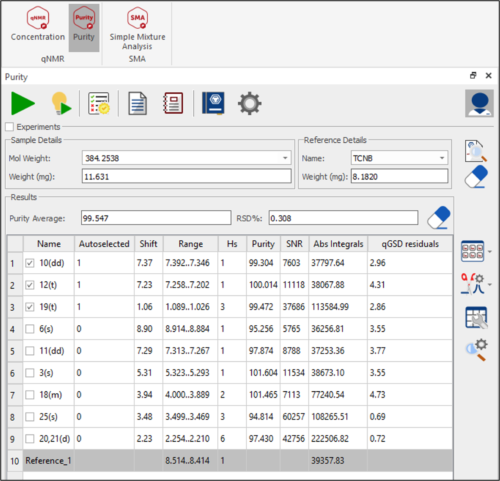
Quantitative NMR analysis made easy!
A wide range of analysis types, from manual to assisted or fully automated batch processing, for all your qNMR concentration and purity determinations.
A dedicated workflow developed to streamline qNMR!
Dealing with big batches of samples routinely? Automate your Purity and Concentration data workflows from end to end with our dedicated Mnova Gears solutions. Please check Gears Purity and Gears Concentration for more information
Mnova qNMR is FREE FOR ACADEMIC LICENSES with an Mnova NMR license.
What’s new in Mnova qNMR 3.2?
The new version of this qNMR plugin has been released with Mnova 14.3.2 and brings a number improvements together with its related Gears automation workflows listed below:
- qNMR
- Updated parameter names for References to enhance user-friendliness: Reference, Reference Name, and RN
- Gears Purity:
- Additional methods for extracting molecular weight
- From the molecule in the document, if it exists
- From the SMILES text in the parameters table, if it exists
- From “MW” or “Molecular Weight” fields in the parameters, if they exist
- Additional methods for extracting molecular weight
- Gears Concentration:
- Increased reporting choices available
- Added units to the average concentration and CCF values in the report
- Reconfigured the settings layout dialogue to enhance visualization
Mnova qNMR: 45-day FREE trial
 1. Download
1. Download
qNMR is a plugin integrated in Mnova. No extra installer is required.
 2. Installation
2. Installation
Open Mnova and go to ‘Help/Get-Install Licenses’. Select ‘Evaluate’.
 3. License
3. License
Fill in the license request form and you will receive your trial license via e-mail.
Help & Resources
 Resources
Resources
qNMR
Highlights
qNMR
Features
PURITY DETERMINATIONS
This module uses the Concentration “engine”, and therefore has all its features. However, this capability has been built to make NMR “Purity” (a.k.a. “Potency”) measurements simple and accurate. As an aside, the same basic functionality can be used to measure salt ratios, and solvent contamination levels.
‘ONE CLICK’ Q-NMR (PURITY)
Optimised tool to obtain your Purity results in one single click using the ‘Advised Analysis’ button. This feature firstly will find your parameters (molecular weight, sample weight, reference compound etc.) Then it will apply optimized settings to carry out the NMR analysis and finally calculate your compounds purity.
Markets
qNMR Users
- Active Pharmaceutical Ingredients (APIs)
- Drug analysis
- Natural products
- Pharmaceutical compound libraries
- Forensic analysis
- Food sciences and many more!








Success Stories











